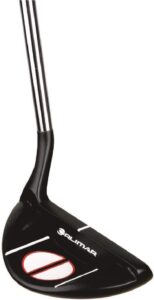Golf, a game of precision and skill, demands not only a steady hand but also the right equipment. When it comes to perfecting your swing, having the right golf chippers can make all the difference. In this comprehensive guide, we will walk you through the intricacies of choosing the best golf chippers for your game. From understanding the types of chippers available to mastering the art of the swing, consider this your go-to manual for improving your golfing experience.
Table of Contents
Introduction to GOLF CHIPPERS
Golf is more than just a game; it’s a pursuit of perfection. Every golfer dreams of that one swing that sails the ball smoothly into the green. One of the most overlooked aspects of a perfect golf shot is the choice of equipment, especially the golf chippers.

Why the Right Golf Chippers Matters
The golf chippers is designed to help you make those short, precise shots around the green. Choosing the right one can significantly impact your overall game. A well-designed chipper can provide accuracy and control, making it easier to land the ball exactly where you want it.
Types of Golf Chippers
Blade Style Golf Chippers
Blade style golf chippers offer a traditional design. They are excellent for golfers who prefer a simple and straightforward approach to chipping. The blade design allows for clean contact with the ball, ensuring precise shots.

Mallet Style Golf Chippers
Mallet style golf chippers, on the other hand, have a larger head and a unique shape. They are great for golfers who need a bit more forgiveness in their shots. The increased surface area makes it easier to connect with the ball consistently.

How to Choose the Perfect Golf Chippers
Consider the Weight and Balance
A Golf chippers weight and balance are crucial factors to consider. The right balance ensures that your swing remains smooth and controlled, allowing for accurate shots.
Grip Comfort and Material
The grip of your golf chippers should feel comfortable in your hands. Rubberized or padded grips can provide excellent traction even in wet conditions, enhancing your control over the club.
Understanding Loft and Bounce
Loft and bounce angles affect how the golf chippers interacts with the grass. Understanding these angles will help you choose a chipper that suits the specific conditions of the golf course you frequent.
Mastering Your Swing Technique
Perfecting Your Stance
A proper stance provides the foundation for a great swing. Your feet should be shoulder-width apart, ensuring stability and balance during your shot.
Understanding the Swing Arc
The swing arc determines the trajectory of your shot. A shallow arc is ideal for low, rolling shots, while a steep arc is suitable for high, soft shots that land softly on the green.
Developing Consistent Follow Through
A consistent follow-through ensures that your shots are accurate and controlled. Practice your follow-through to achieve a smooth and natural motion.
Tips and Tricks from the Pros
Professional golfers emphasize the importance of practice and patience. Dedicate time to practice your chipping skills regularly, and you’ll see a significant improvement in your game.
Maintaining Your Golf ChipperS
Regular cleaning and inspection are essential to keep your chipper in top condition. Inspect the clubface for wear and clean the grooves to maintain optimal performance.
Storage Tips
Store your chipper in a cool, dry place to prevent rust and damage. Consider investing in a headcover to protect the clubface from scratches.
Common Mistakes to Avoid
Gripping Too Tightly
A tight grip restricts your wrist movement, making it challenging to achieve a smooth swing. Maintain a firm yet relaxed grip for better control.
Ignoring the Importance of Balance
Balance is key to a successful chip shot. Ensure your weight is evenly distributed between both feet to maintain stability during your swing.
Neglecting Practice
Improving your chipping skills requires consistent practice. Dedicate time to short game practice sessions to enhance your technique and confidence.
Conclusion
Mastering your swing with the best golf chippers is not just about skill; it’s about having the right tool for the job. By understanding the different types of golf chippers, choosing the perfect one for your game, and practicing your technique, you can significantly enhance your golfing experience. Remember, patience and persistence are your best allies on the journey to becoming a master of the green.
FAQs (Frequently Asked Questions)
How do I know which type of chipper is suitable for my playing style?
Consider your preferences and weaknesses. If you need more forgiveness, go for a mallet style chipper. If you prefer a traditional approach, opt for a blade style chipper.
Can a chipper be used for long shots as well?
While chippers are designed for short shots around the green, with practice, skilled golfers can use them for longer shots. However, it’s recommended to use appropriate clubs for long-distance shots.
How often should I practice my chipping skills?
Regular practice is essential. Aim for at least a few short game practice sessions per week to maintain and improve your chipping skills.
Should I consider the material of the chipper head?
Yes, the material can impact the club’s durability and performance. Stainless steel and aluminum heads are popular choices due to their durability and lightweight nature.
Can a chipper help in reducing my overall golf score?
Absolutely. Mastering chipping can save you strokes around the green, leading to a lower overall score. Practice chipping to improve your short game and lower your scores.
